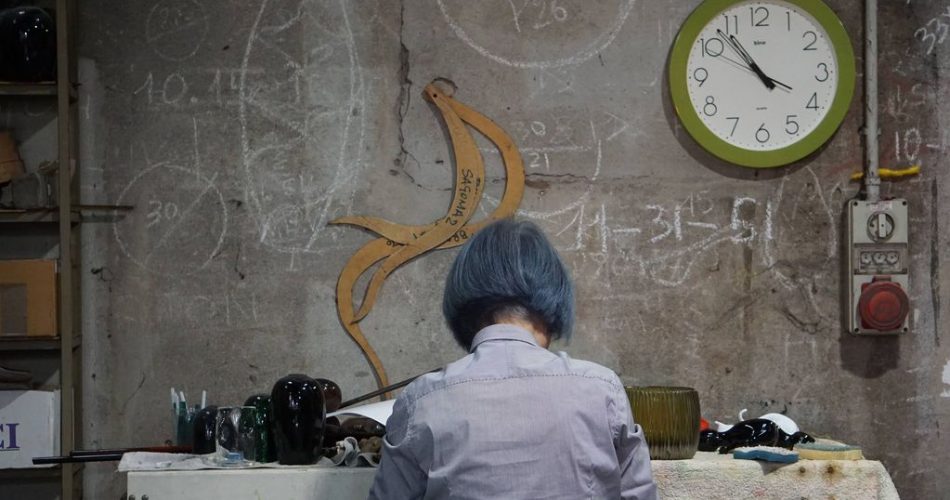How a traditional Italian glass-making craft met Japanese aesthetics
To the north of Venice, Italy lies a chain of islands called Murano. For the unenlightened, Murano is famous internationally for its exquisite, hand-crafted glass called (well, you guessed it) Murano glass. It is also known as Venetian glass, as the glassblowing technique which it uses originated in Venice and only moved to Murano in the 13th century. This special glass-making technique which has been passed down and honed for over a millennium is what sets Murano glass apart from any other in the world.

The unparalleled beauty of Murano glass is attributable to the skillful way in which the chemistry of natural elements is utilized. Gold, silver, cobalt, copper, zinc – every element adds its distinctive color to the glass creating a scintillating blend of hues. And no two Murano glassware are alike! Each piece is carefully crafted by hand not by mere craftsmen but by artists of glassmaking called Maestros in Italian. This is why Murano glass is also called art glass – each piece is an artwork in its right. No wonder this art which requires impeccable craftsmanship and contains in itself a long and rich history, is valued so highly across the globe.

Now let’s zoom out for a bit and jump over to the other corner of the world – in Japan, to be specific.
Unlike the Western norms of beauty and aesthetics which are often trend-based, the concept of aesthetics in Japan comprises various ideals, which have been coexisting since time immemorial. They are so intricately woven into society and culture that they form an important part of daily life. Very crudely speaking, these ideals place emphasis on tranquillity and simplicity, on asymmetry and originality. They define beauty as subtle grace, as elegance in the absence of pretense.

ottmarliebert.com from Santa Fe, Turtle Island, CC BY-SA 2.0 , via Wikimedia Commons
Wabi-sabi is an ancient Japanese philosophy of appreciating beauty in imperfection and transience. Tea ceremony masters, for instance, greatly value the rustic beauty in articles that are handmade and irregularly shaped.
Now imagine using Venetian technology of glassmaking to articulate these Japanese ideals. It’s extraordinary, yes. But not far-fetched. ‘Cause, a small store in Tokyo is doing exactly this.
In the neighborhood of Shibuya in Tokyo, a devoted group of Japanese designers and Italian maestros, under the name of Chisa, are breathing life into this unique Italian-Japanese fusion.

(Product being made: https://chisa.jp/collections/interior/products/triangular-pyramid-flower-vase-20)
While there are other Murano glass brands in Japan, what sets Chisa apart is that they do not forsake the natural characteristics of either the Venetian glass-making technique or Japanese aesthetics in an attempt to integrate the two. Quite the contrary, in fact. Each of their artwork is a magnificent symphony between Japanese beauty ideals and Venetian glass – rather than the two aspects competing against the other, both complement each other beautifully. Instead of merely using Murano glass as the medium to carve out traditional Japanese aesthetics, Chisa strives to marry the two and unleash their complementary beauty.

The uniquely shaped mouth is derived from the “katakuchi”, a special Japanese spouted bottle used for serving sake.
(Product link: https://chisa.jp/collections/vase/products/blue-aw-meta)

(Product link: https://chisa.jp/collections/tableware/products/inase-jima-rosso)

(Product link: https://chisa.jp/collections/tableware/products/edo-koiki-quattro-elba-11-8)
But how did this tryst between a traditional Italian art and the Japanese philosophy of beauty begin?
The answer lies in one person – Chisako Kotaki. A leading pioneer of Murano glass and costume jewelry in Japan, Kotaki-san stumbled upon Murano glass during her time as an Air France employee. And ever since then, she has been captivated by its rich legacy and has been striving to convey its profound beauty to the world. Her sheer love for this Venetian craft and her constant sincere endeavors have led her to amass an incredible experience of over 40 years as a Murano glass collector and researcher.

It was her strong desire to introduce Murano glass to the Japanese community that led her to establish the first-ever Venetian specialist store in Japan in 1983. “I wish to bring forth items that can seamlessly blend with and complement the Japanese lifestyle,” Kotaki-san elaborates. She eventually launched her very own brand called Chisa to further her aim “to incorporate high-quality Murano glass and vintage jewelry into everyday life.”
I had the honour of having a tête-à-tête with Kotaki-san last year. I was genuinely touched by the humility and courtesy with which she talked to a mere student like me, despite her being the very embodiment of elegance and excellence. I could also not help but marvel at the spark in her eyes whenever she spoke about Murano glass and how it holds within its smooth curves and dazzling colors a legacy that has been handed down for hundreds of years.

Kotaki-san’s love for Venetian glass flows not only in her words but also in the designs that she meticulously crafts. To this date, she herself designs all the original artworks that Chisa puts out. She pours out her heart in her work, which is evident from the resulting beautiful blend of Italian and Japanese aesthetics. One does not need to be a connoisseur of Venetian art to see that Kotaki-san’s handicrafts behold a different magic in them.

Every Chisa artwork is an extraordinary embodiment of the union of Italian and Japanese history, art, and aesthetics. Imagine having an object with such incredible artistic and historical value decorating your living room as a Murano chandelier or perhaps your wrist as a Venetian beads’ bracelet. And you don’t even have to take the trouble of travelling to Murano or Tokyo. ‘Cause with Chisa’s online store and worldwide shipping, you can add a unique artistic touch to your daily life simply from the comfort of your home. You’re sure to find something to suit your fancy. So don’t keep waiting. Adorn your kingdom.
<links to Chisa’s Instagram, Facebook, and website>
https://www.instagram.com/chisa_international/
https://www.facebook.com/Chisa.international
https://chisa.jp/ (if posting on a site other than Chisa.jp)


Comments